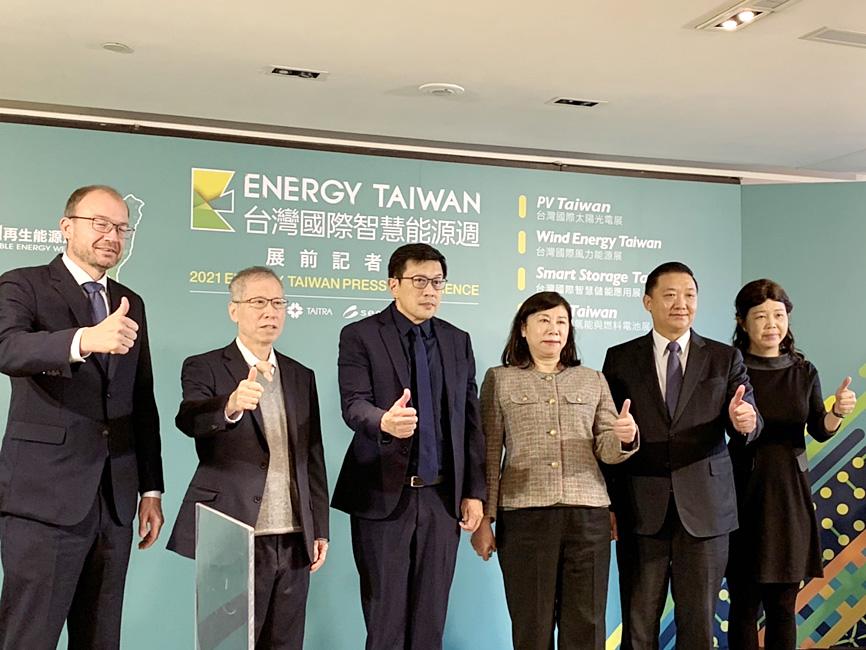Solar module maker United Renewable Energy Co (聯合再生能源) yesterday said it aims to develop 30 percent more solar energy capacity totaling 300 megawatts (MW) next year by turning fish ponds and barren farmland into solar power facilities.
The Hsinchu-based company attributed the growth to the government’s efforts to shift to renewable energy sources from coal-fired energy by 2025.
This year, United Renewable Energy has landed about 400 solar projects with combined capacity of 230MW through collaboration with local governments.

Photo: Chang Hui-wen, Taipei Times
The company has won bids to install solar arrays atop rooftops at schools, parking lots, government-owned dormitories, as well as floating panels on fish ponds, it said.
As more solar power facilities are to be completed and connected to the electricity grid, United Renewable Energy expects to book income of NT$2.5 billion (US$90.02 million) from selling about 100MW of solar power next year, it said.
It is also making inroads into the solar storage segment and is to showcase a shipping container-sized large-capacity modular battery pack at the Energy Taiwan trade show, which starts today and finishes on Friday at the Nangang Exhibition Center’s Hall 2 in Taipei.
United Renewable Energy chairman Sam Hong (洪傳獻) called on the government to plan a renewable energy storage policy before the capacity of feeders, deployed by Taiwan Power Co (Taipower, 台電), reaches its limit of 10 gigawatts (GW).
Solar power and other forms of renewable energy are interconnected to Taipower’s electricity grids through feeder installations.
“With energy storage systems, solar power can ensure stable power supply and play a bigger role in the nation’s electricity supply, rather than being an alternative,” Hong said.
The government should offer more incentives — such as tax breaks on equipment investments or boosting feed-in tariffs — to encourage the adoption of energy storage, he said.
With just 6.6GW of solar energy capacity deployed so far, Hong said that the government is in “a dire situation” regarding its goal of building 20GW of solar energy infrastructure by 2025.
The government should accelerate the release of under-utilized land for solar panel installations, he said.
The firm said it estimates that 20,000 hectares are required to install enough solar panels for 20GW of capacity, while there are 400,000 hectares of abandoned farmland.
Separately, GreenPeak Renewables Co (鑫世紀國際開發), a solar energy platform backed by leading alternative investment firm Stonepeak Infrastructure Partners, yesterday signed a syndicated loan of NT$ 2.1 billion with KGI Bank (凱基銀行), E.Sun Commercial Bank (玉山銀行) and Taipei Fubon Commercial Bank (台北富邦銀行) to fund its Yu Chang Solar Project (昱昶能源太陽發電光電廠).
Yu Chang is expected to produce 58 million kilowatt-hours per year, reducing carbon emissions by an amount equivalent to planting the number of trees in 75 Daan Forest Parks, GreenPeak Renewables said in a statement.
The Yunlin County-based project is expected to provide energy to more than 14,000 households, or the equivalent of 7 percent of the county’s power demand, it said.

Zhang Yazhou was sitting in the passenger seat of her Tesla Model 3 when she said she heard her father’s panicked voice: The brakes do not work. Approaching a red light, her father swerved around two cars before plowing into a sport utility vehicle and a sedan, and crashing into a large concrete barrier. Stunned, Zhang gazed at the deflating airbag in front of her. She could never have imagined what was to come: Tesla Inc sued her for defamation for complaining publicly about the vehicles brakes — and won. A Chinese court ordered Zhang to pay more than US$23,000 in

Taiwan Semiconductor Manufacturing Co (TSMC, 台積電) yesterday said that its investment plan in Arizona is going according to schedule, following a local media report claiming that the company is planning to break ground on its third wafer fab in the US in June. In a statement, TSMC said it does not comment on market speculation, but that its investments in Arizona are proceeding well. TSMC is investing more than US$65 billion in Arizona to build three advanced wafer fabs. The first one has started production using the 4-nanometer (nm) process, while the second one would start mass production using the

US President Donald Trump has threatened to impose up to 100 percent tariffs on Taiwan’s semiconductor exports to the US to encourage chip manufacturers to move their production facilities to the US, but experts are questioning his strategy, warning it could harm industries on both sides. “I’m very confused and surprised that the Trump administration would try and do this,” Bob O’Donnell, chief analyst and founder of TECHnalysis Research in California, said in an interview with the Central News Agency on Wednesday. “It seems to reflect the fact that they don’t understand how the semiconductor industry really works,” O’Donnell said. Economic sanctions would

‘NO DISRUPTION’: A US trade association said that it was ready to work with the US administration to streamline the program’s requirements and achieve shared goals The White House is seeking to renegotiate US CHIPS and Science Act awards and has signaled delays to some upcoming semiconductor disbursements, two sources familiar with the matter told reporters. The people, along with a third source, said that the new US administration is reviewing the projects awarded under the 2022 law, meant to boost US domestic semiconductor output with US$39 billion in subsidies. Washington plans to renegotiate some of the deals after assessing and changing current requirements, the sources said. The extent of the possible changes and how they would affect agreements already finalized was not immediately clear. It was not known